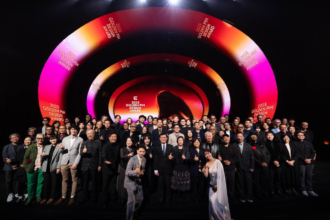- How is AI reshaping brand communications in Asia?
AI is fundamentally reshaping how brands communicate – moving us from surface-level automation to a future of truly meaningful, hyper-personalised engagement. Our latest 2025 State of Customer Engagement Report revealed that Asia Pacific (APAC) organisations are already using AI to analyse customer needs and pain points (83%), accelerate issue resolution (83%), identify emerging behaviours through predictive analytics (81%), and more.
However, AI’s rapid adoption, while promising, has led to a flood of content that is making it harder for brands to cut through the noise. This challenge is particularly acute in Asia, a highly diverse, multilingual, mobile-first market where customers are accustomed to deeply integrated, data-rich experiences. When brand communications lack genuine personality and context, customers are more likely to sense a disconnect.
The challenge for businesses isn’t just to use AI, but to master it. The real opportunity isn’t about making more content with AI, but in leveraging it to achieve authentic personalisation that builds real customer relationships where every message feels both relevant and human.
- Can you unpack how algorithms and playbooks are changing the way we approach marketing, and why we are seeing a growing disconnect between brands and consumers despite the surge in content and data?
As organisations lean too heavily on algorithms and playbooks, marketing has slipped into a cycle of rinse and repeat. This leads to brand experiences that feel generic and increasingly forgettable. Despite access to more data and automation tools than ever, we’re seeing a rise in uninspired, one-size-fits-all messages. The result is run-of-the-mill marketing campaigns that, instead of engaging with their audience, make customers tune out and stop caring.
The problem is, we’re not using data in the right way. It’s become a tool to pump out more content, not to understand customers. We’re confusing quantity with quality and missing the chance to build real connections.
Consumers in the Asia-Pacific region are especially savvy. They expect great digital experiences and can spot a robotic message right away. They won’t stick around if the content is boring or out of context. Generic content just pushes them away, and with AI creating so much of it, the problem is only growing. We have to do better and move beyond using simple, quick prompts and having an over-reliance on algorithms. Whether we like it or not, this can unintentionally create bland, impersonal experiences that push people away.
- How can brands use AI as a creative partner to reignite their brand identity and stand out in a saturated content landscape?
To stand out, brands need to use AI as a creative partner, not just for automation but for imagination. The key is to be grounded in a clear brand identity and guided by human oversight. Always start by understanding your customer, not just as data points, but as a person on a journey with your brand. Our research reveals that 92% of APAC respondents are more likely to buy from a brand that personalises its engagement in real-time. AI is a great tool for being able to achieve this at scale.
With a full view of the customer, built on a foundation of unified first-party data, AI becomes a powerful co-creator. It’s like a creative sandbox where teams can quickly test ideas, make messages more exact, and improve things based on what customers actually do. For instance, by using an AI-powered automated voice response system for reservations, Chope was able to cut its no-show rates by half, as well as seamlessly communicate with diners in different languages.
This frees up marketers to be more creative, while AI handles the heavy lifting of data analysis and personalisation. By combining human creativity with the precision of AI, brands can stand out and build genuine connections with their customers.
- What is your advice for businesses in Asia to drive hyper-personalised, context-aware communications across channels?
Knowing your customer in real time is only the first step. Businesses should use predictive analytics to anticipate what a customer might need next, rather than simply reacting to their last action. Our research shows 81% of APAC businesses are already using AI for predictive analytics, but the real differentiator is using those insights in a way that actually matters to the customer.
Brands should also approach communications through a customer-centric lens, rather than being channel-centric. Sending the right message, on the right channel, at the right time, with content that genuinely resonates with their current context, will be critical.
Personalisation has become non-negotiable, with 76% of APAC consumers likely to abandon purchases if engagements feel impersonal. For example, if a customer has been looking at cancellation policies online, an AI-powered agent should already know this and shift its goal from upselling to solving their problem.
When we talk about personalisation, people always bring up trust and privacy. We believe that consumers will share their data as long as they get something valuable in return. For example, people will share their height and weight with a fitness app if the app helps them track calories and offer tips for building muscle or losing weight.
- With AI adoption accelerating, what is the enduring role of human creativity in marketing and how should teams strike the right balance between automation and originality?
As AI adoption accelerates, the role of human creativity hasn’t just stayed relevant – it has become indispensable. AI is a powerful tool for efficiency and scale, but true originality, empathy, and the ability to spark genuine emotional connection are ultimately still uniquely human domains. An over-reliance on AI without human oversight will only lead to the proverbial “sea of sameness”, where marketing content is produced using the same AI models that are trained on similar data. What’s next will be a future where marketing content is bland and generic.
To avoid this, brands must put creativity first. They should create new rules for messaging that ensure their content is original and real. The best way to do this is to see AI as a co-pilot, not the main author. The value of AI is in data analysis and scaling repetitive tasks, which gives teams more time to think strategically and create powerful stories that connect with people.
The future of marketing is not about AI or humans, but the powerful synergy of the two. Brands that empower their creative teams with AI tools, while still prioritising human ingenuity and strategic oversight, will be the ones that succeed in the marketplace and build lasting customer relationships.
















